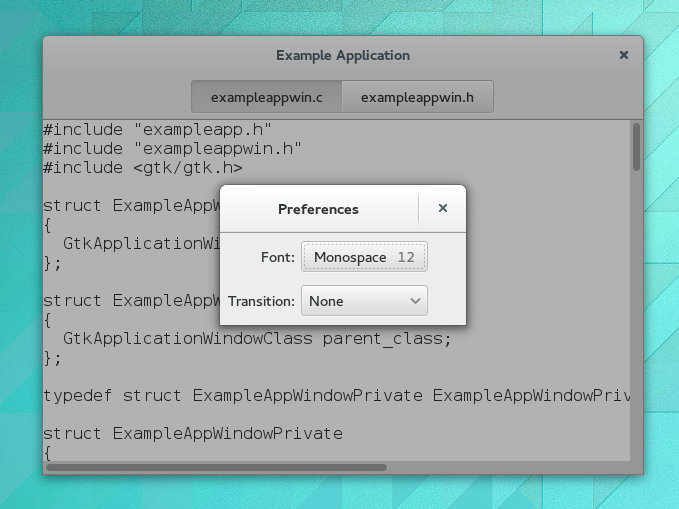一个偏好对话框
一个典型的应用程序应该有一些偏好设置,在每次打开时都能被记住。即使是为这个小范例程序,我们也将想改变正文的字体。
我们将用GSettings 来保存偏好设置,GSettings 需要一个描述我们设置的模式。
<?xml version="1.0" encoding="UTF-8"?>
<schemalist>
<schema path="/org/gtk/exampleapp/" id="org.gtk.exampleapp">
<key name="font" type="s">
<default>'Monospace 12'</default>
<summary>Font</summary>
<description>The font to be used for content.</description>
</key>
<key name="transition" type="s">
<choices>
<choice value='none'/>
<choice value='crossfade'/>
<choice value='slide-left-right'/>
</choices>
<default>'none'</default>
<summary>Transition</summary>
<description>The transition to use when switching tabs.</description>
</key>
</schema>
</schemalist>
当我们在应用程序中使用这个模式之前,我们需要从GSettings 中将这编译进二进制文件。GIO 提供macros来在工程中做这件事。
接着,我们需要连接settings 和我们的目标部件。一个简便的方法是用GSettings bind 函数绑定设定关键词和目标属性,就像我们这里为转换设置做的。
...
static void
example_app_window_init (ExampleAppWindow *win)
{
ExampleAppWindowPrivate *priv;
priv = example_app_window_get_instance_private (win);
gtk_widget_init_template (GTK_WIDGET (win));
priv->settings = g_settings_new ("org.gtk.exampleapp");
g_settings_bind (priv->settings, "transition",
priv->stack, "transition-type",
G_SETTINGS_BIND_DEFAULT);
}
...
这个连接字体设置的代码有点儿复杂,因为我们没有对应的简单的目标属性,我们本没打算这么做。
至此,如果我们改变一个设置,程序将会有反应,比如用gsettings 命令行工具。当然,我们希望应用程序提供一个偏好对话框。所以干吧,我们的偏好对话框是GtkDialog 的子类,我们将使用我们已经用过的技术:templates,private structs, settingbindings。
让我们从模板开始。
<?xml version="1.0" encoding="UTF-8"?>
<interface>
<!-- interface-requires gtk+ 3.8 -->
<template class="ExampleAppPrefs" parent="GtkDialog">
<property name="title" translatable="yes">Preferences</property>
<property name="resizable">False</property>
<property name="modal">True</property>
<child internal-child="vbox">
<object class="GtkBox" id="vbox">
<child>
<object class="GtkGrid" id="grid">
<property name="visible">True</property>
<property name="margin">6</property>
<property name="row-spacing">12</property>
<property name="column-spacing">6</property>
<child>
<object class="GtkLabel" id="fontlabel">
<property name="visible">True</property>
<property name="label">_Font:</property>
<property name="use-underline">True</property>
<property name="mnemonic-widget">font</property>
<property name="xalign">1</property>
</object>
<packing>
<property name="left-attach">0</property>
<property name="top-attach">0</property>
</packing>
</child>
<child>
<object class="GtkFontButton" id="font">
<property name="visible">True</property>
</object>
<packing>
<property name="left-attach">1</property>
<property name="top-attach">0</property>
</packing>
</child>
<child>
<object class="GtkLabel" id="transitionlabel">
<property name="visible">True</property>
<property name="label">_Transition:</property>
<property name="use-underline">True</property>
<property name="mnemonic-widget">transition</property>
<property name="xalign">1</property>
</object>
<packing>
<property name="left-attach">0</property>
<property name="top-attach">1</property>
</packing>
</child>
<child>
<object class="GtkComboBoxText" id="transition">
<property name="visible">True</property>
<items>
<item translatable="yes" id="none">None</item>
<item translatable="yes" id="crossfade">Fade</item>
<item translatable="yes" id="slide-left-right">Slide</item>
</items>
</object>
<packing>
<property name="left-attach">1</property>
<property name="top-attach">1</property>
</packing>
</child>
</object>
</child>
</object>
</child>
</template>
</interface>
接下来是对话框子类。
#include <gtk/gtk.h>
#include "exampleapp.h"
#include "exampleappwin.h"
#include "exampleappprefs.h"
struct _ExampleAppPrefs
{
GtkDialog parent;
};
struct _ExampleAppPrefsClass
{
GtkDialogClass parent_class;
};
typedef struct _ExampleAppPrefsPrivate ExampleAppPrefsPrivate;
struct _ExampleAppPrefsPrivate
{
GSettings *settings;
GtkWidget *font;
GtkWidget *transition;
};
G_DEFINE_TYPE_WITH_PRIVATE(ExampleAppPrefs, example_app_prefs, GTK_TYPE_DIALOG)
static void
example_app_prefs_init (ExampleAppPrefs *prefs)
{
ExampleAppPrefsPrivate *priv;
priv = example_app_prefs_get_instance_private (prefs);
gtk_widget_init_template (GTK_WIDGET (prefs));
priv->settings = g_settings_new ("org.gtk.exampleapp");
g_settings_bind (priv->settings, "font",
priv->font, "font",
G_SETTINGS_BIND_DEFAULT);
g_settings_bind (priv->settings, "transition",
priv->transition, "active-id",
G_SETTINGS_BIND_DEFAULT);
}
static void
example_app_prefs_dispose (GObject *object)
{
ExampleAppPrefsPrivate *priv;
priv = example_app_prefs_get_instance_private (EXAMPLE_APP_PREFS (object));
g_clear_object (&priv->settings);
G_OBJECT_CLASS (example_app_prefs_parent_class)->dispose (object);
}
static void
example_app_prefs_class_init (ExampleAppPrefsClass *class)
{
G_OBJECT_CLASS (class)->dispose = example_app_prefs_dispose;
gtk_widget_class_set_template_from_resource (GTK_WIDGET_CLASS (class),
"/org/gtk/exampleapp/prefs.ui");
gtk_widget_class_bind_template_child_private (GTK_WIDGET_CLASS (class), ExampleAppPrefs, font);
gtk_widget_class_bind_template_child_private (GTK_WIDGET_CLASS (class), ExampleAppPrefs, transition);
}
ExampleAppPrefs *
example_app_prefs_new (ExampleAppWindow *win)
{
return g_object_new (EXAMPLE_APP_PREFS_TYPE, "transient-for", win, "use-header-bar", TRUE, NULL);
}
现在我们再看preferences_activated()函数,使它打开一个偏好对话框。
...
static void
preferences_activated (GSimpleAction *action,
GVariant *parameter,
gpointer app)
{
ExampleAppPrefs *prefs;
GtkWindow *win;
win = gtk_application_get_active_window (GTK_APPLICATION (app));
prefs = example_app_prefs_new (EXAMPLE_APP_WINDOW (win));
gtk_window_present (GTK_WINDOW (prefs));
}
...
完成所有这些工作后,我们的应用程序现在可以像这样显示一个偏好对话框:
